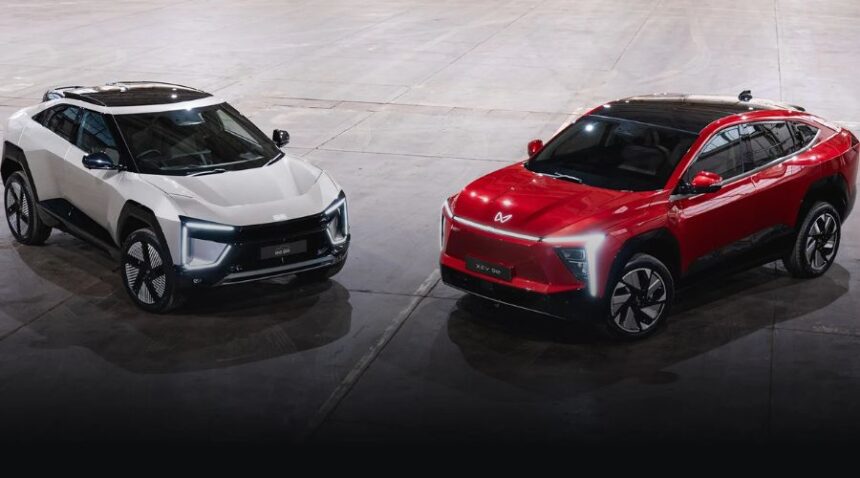The exterior and interior designs of the Mahindra BE 6e and XEV 9e are drastically different, despite the fact that they have many identical characteristics.
Two of the automaker’s most cutting-edge EVs, the recently unveiled Mahindra BE 6e and XEV 9e, have already made an impression. Although they both have some of the newest features and technology, their exterior and internal designs are very different. Here’s a closer look at the main distinctions between the BE 6e and XEV 9e’s external and interior designs.
FRONT
The XEV 9e features a vertical housing arrangement for the headlights and the “Infinite Possibilities” emblem, while the BE 6e features dual-barrel LED projector headlights that are vertically stacked with an illuminated “BE” logo.
Regarding the LED DRLs, the XEV 9e has inverted L-shaped linked DRLs, while the BE 6e sports C-shaped units. As is common with EVs, both feature blanked-off grilles. The lower bumpers also differ; the XEV 9e has a silver appliqué but no fog lamps, while the BE 6e adds fog lamps and a silver skid plate for an aggressive appearance.
SIDE
The black body cladding, window line, and roofline of the Mahindra BE 6e and XEV 9e are all comparable in profile. The front door handles of both EVs fit flush, and the rear door handles are built into the C-pillar. Although both variants have 19-inch alloy wheels with an aerodynamic design, the two EVs have different designs.
REAR
The XEV 9e has inverted L-shaped LED tail lights, while the BE 6e has C-shaped LED tail lights. A rear windshield-mounted spoiler is standard on both EVs, but the BE 6e’s one is designed to be more aggressive. The XEV 9e’s rear bumper features a more straightforward silver appliqué, whereas the BE 6e’s silver skid plate is divided into two halves. The “Infinity” emblem is identical on the tailgates of both vehicles.
INTERIOR AND FEATURES
Although the cabins of both EVs have two different colors, the BE 6e’s interior has a more modern appearance, while the XEV 9e has a more understated style. The BE 6e has two 12.3-inch dashboard displays, while the XEV 9e has three.
A redesigned two-spoke steering wheel with various lit emblems in the center is shared by both EVs. The XEV 9e lacks the BE 6e’s curved trim that runs from the dashboard to the center console, giving it a cockpit-like feel. The center consoles also differ; the XEV 9e’s drive selector was modeled after the Mahindra XUV400 EV, while the BE 6e’s was inspired by an airplane.
The XEV 9e has white leatherette upholstery with black accents, while the BE 6e has dual-tone fabric and leatherette upholstery.
Premium amenities include a 16-speaker Harman Kardon sound system, a panoramic sunroof, wireless phone charging (two units on the BE 6e), multi-zone air conditioning, and a heads-up display based on augmented reality, which is standard on both the BE 6e and XEV 9e.
Both variants come equipped with a 360-degree camera, seven airbags, park assist, and a Level 2 Advanced Driver Assistance Systems (ADAS) suite that includes driver fatigue detection and automated emergency braking.
BATTERY PACK AND PERFORMANCE
Fast charging is supported by both EVs for convenient top-ups. The smaller 59 kWh battery charges at 140 kW, requiring only 20 minutes to get from 20 to 80 percent charge, while the larger battery pack charges at 175 kW. For the BE 6e and XEV 9e, Mahindra additionally offers two AC charging options: 7.3 kWh and 11.2 kWh.
PRICE AND RIVALS
The base models of the BE 6e and XEV 9e, which both have a 59 kWh battery pack, had their prices revealed by Mahindra. The XEV 9e is priced at Rs 21.90 lakh (both introductory ex-showroom, pan-India), while the BE 6e starts at Rs 18.90 lakh.
While the XEV 9e will compete with the incoming Tata Harrier EV and Tata Safari EV, the BE 6e competes with the Tata Curvv EV, MG ZS EV, the upcoming Maruti eVX, and the Hyundai Creta EV.







